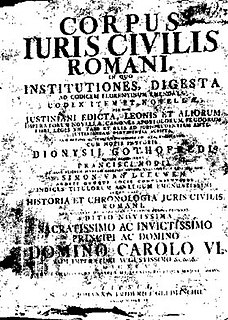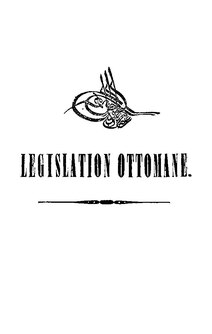Related Research Articles

The Corpus JurisCivilis is the modern name for a collection of fundamental works in jurisprudence, issued from 529 to 534 by order of Justinian I, Byzantine Emperor. It is also sometimes referred to metonymically after one of its parts, the Code of Justinian.
Legal history or the history of law is the study of how law has evolved and why it has changed. Legal history is closely connected to the development of civilisations and operates in the wider context of social history. Certain jurists and historians of legal process have seen legal history as the recording of the evolution of laws and the technical explanation of how these laws have evolved with the view of better understanding the origins of various legal concepts; some consider legal history a branch of intellectual history. Twentieth-century historians viewed legal history in a more contextualised manner - more in line with the thinking of social historians. They have looked at legal institutions as complex systems of rules, players and symbols and have seen these elements interact with society to change, adapt, resist or promote certain aspects of civil society. Such legal historians have tended to analyse case histories from the parameters of social-science inquiry, using statistical methods, analysing class distinctions among litigants, petitioners and other players in various legal processes. By analyzing case outcomes, transaction costs, and numbers of settled cases, they have begun an analysis of legal institutions, practices, procedures and briefs that gives a more complex picture of law and society than the study of jurisprudence, case law and civil codes can achieve.

The Codex Theodosianus was a compilation of the laws of the Roman Empire under the Christian emperors since 312. A commission was established by Emperor Theodosius II and his co-emperor Valentinian III on 26 March 429 and the compilation was published by a constitution of 15 February 438. It went into force in the eastern and western parts of the empire on 1 January 439. The original text of the codex is also found in the Breviary of Alaric, promulgated on 2 February 506.

A cestus or caestus is a battle glove that was sometimes used in Roman gladiatorial events. It was based on a Greek original. It was worn like a modern boxing glove, but was made from hard leather strips that enclosed and protected the fist and lower arm. Some were fitted with studs or spikes to inflict potentially lethal injuries. Cestus fighters seem to have had no form of body armour, apart from the cestus itself. Contemporary depictions show the cestus worn in pairs.

The Apostolic Canons, Apostolic canons, Ecclesiastical Canons of the Same Holy Apostles, or Canons of the Holy Apostles, is a 4th-century Syrian Christian text. It is an Ancient Church Order, a collection of ancient ecclesiastical canons concerning the government and discipline of the Early Christian Church, allegedly written by the Apostles. This text is an appendix to the eight book of the Apostolic Constitutions. Like the other Ancient Church Orders, the Apostolic Canons uses a pseudepigraphic form.

Byzantine law was essentially a continuation of Roman law with increased Orthodox Christian and Hellenistic influence. Most sources define Byzantine law as the Roman legal traditions starting after the reign of Justinian I in the 6th century and ending with the Fall of Constantinople in the 15th century. Although future Byzantine codes and constitutions derived largely from Justinian's Corpus Juris Civilis, their main objectives were idealistic and ceremonial rather than practical. Following Hellenistic and Near-Eastern political systems, legislations were tools to idealize and display the sacred role and responsibility of the emperor as the holy monarch chosen by God and the incarnation of law "nómos émpsychos", thus having philosophical and religious purposes that idealized the perfect Byzantine king.
Gamaliel VI was the last nasi of the ancient Sanhedrin.
The Fetha Negest is a theocratic legal code compiled around 1240 by the Coptic Egyptian Christian writer Abu'l-Fada'il ibn al-Assal in Arabic. It was later translated into Ge'ez in Ethiopia in the 15th century and expanded upon with numerous local laws. Ibn al-Assal took his laws partly from apostolic writings, and partly from former law codes of the Byzantine rulers.
This is a history of same-sex unions in cultures around the world. Various types of same-sex unions have existed, ranging from informal, unsanctioned, and temporary relationships to highly ritualized unions that have included marriage. State-recognized same-sex unions have recently become more widely accepted, with various countries recognizing same-sex marriages or other types of unions. A celebrated achievement in LGBT history occurred when Queen Beatrix signed a law making Netherlands the first country to legalize same-sex marriage.

Christianization of the Roman Empire began around AD 30–40, slowly and amidst opposition, in the Roman province of Judaea in the region of Palestine. Scholars disagree over numbers and the length of time Christianization took; it is generally thought to have begun with fewer than 1000 people, reaching approximately 200,000 converts by the end of the second century, half of the empire's population by 350, and eventually encompassing the majority of its 60–70 million people in the fifth – or possibly the sixth – century. From the earliest studies, scholars have sought to understand the conversion of an entire society by asking what sociologist Rodney Stark has described as the central question: "How was it done?" Ancient historian Adam Schor observes that this question has, "more than any other, shadowed the study of late Roman history".
The Codex Gregorianus is the title of a collection of constitutions of Roman emperors over a century and a half from the 130s to 290s AD. It is believed to have been produced around 291–4 but the exact date is unknown.
Fred Heinrich Blume, or Fred H. Blume, as he referred to himself, was a German-born American attorney and judge. He served as a justice of the Wyoming Supreme Court for 42 years, from 1922 to 1963, and by himself translated from Latin into English the Codex Justinianus and the Novels, two parts of the Corpus Juris Civilis.
Under Pope Pius XII, there were the several reforms of Catholic Eastern canon law applying to the Eastern Catholic Churches.
The Novellae Constitutiones, or Justinian's Novels, are now considered one of the four major units of Roman law initiated by Roman emperor Justinian I in the course of his long reign. The other three pieces are: the Codex Justinianus, the Digest, and the Institutes. Justinian's quaestor Tribonian was primarily responsible for compiling these last three. Together, the four parts are known as the Corpus Juris Civilis. Whereas the Code, Digest, and Institutes were designed by Justinian as coherent works, the Novels are diverse laws enacted after 534 that never were officially compiled during his reign.
The religious policies of Constantius II were a mixture of toleration for some pagan practices and repression for other pagan practices. He also sought to advance the Arian or Semi-Arianian heresy within Christianity. These policies may be contrasted with the religious policies of his father, Constantine the Great, whose Catholic orthodoxy was espoused in the Nicene Creed and who largely tolerated paganism in the Roman Empire. Constantius also sought to repress Judaeism.
Florentinus was a Roman politician who served as Urban prefect of Rome from 395 to 397 AD.
Clyde Pharr was an American classics professor at Ohio Wesleyan University, Southwestern Presbyterian University, Vanderbilt University, and, finally, at the University of Texas at Austin.

The Code of Justinian is one part of the Corpus Juris Civilis, the codification of Roman law ordered early in the 6th century AD by Justinian I, who was Eastern Roman emperor in Constantinople. Two other units, the Digest and the Institutes, were created during his reign. The fourth part, the Novellae Constitutiones, was compiled unofficially after his death but is now also thought of as part of the Corpus Juris Civilis.

Législation ottomane, ou Recueil des lois, règlements, ordonnances, traités, capitulations et autres documents officiels de l'Empire ottoman is a collection of Ottoman law published by Gregory Aristarchis and edited by Demetrius Nicolaides. The volumes were published from 1873 to 1888.
The Tascodrugites were a sect active in Galatia in the fourth and fifth centuries AD, and possibly as late as the ninth. Ancient sources present them variously as Gnostics or heterodox Christians. Most likely they were Montanists.
References
- ↑ Pharr, Clyde (1952) The Theosdian Code and Novels and the Sirmondian Constitutions Princeton University Press, Pharr
- ↑ Huck, O. (January 2004). "Encore à propos des Sirmondiennes… : arguments présentés à l'appui de la thèse de l'authenticité, en réponse à une mise en cause récente". Antiquité Tardive (in German). 11: 181–196. doi:10.1484/J.AT.2.300257. ISSN 1250-7334.
- ↑ Esders, Stefan; Reimitz, Helmut (2019). "After Gundovald, before Pseudo-Isidore: episcopal jurisdiction, clerical privilege and the uses of Roman law in the Frankish kingdoms". Early Medieval Europe. 27 (1): 85–111. doi: 10.1111/emed.12315 . ISSN 1468-0254.